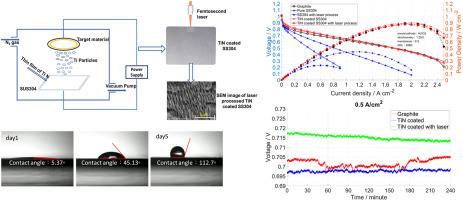Fabrication of superhydrophobic TiN-coated SS304 flow field plates via femtosecond laser processing for fuel cell applications
IF 8.1
2区 工程技术
Q1 CHEMISTRY, PHYSICAL
引用次数: 0
Abstract
Fuel cell systems are potential power sources for transportation applications due to their high energy efficiency, rapid start-up, and low emissions. The bipolar plates, which constitute the major volume of the fuel cell stack, are usually made of graphite. However, the brittle nature of graphite plates makes them unable to resist shock or vibration; as a result, metallic plates are considered as bipolar plates in fuel cell stacks due to their resistance to impact, strength, and cost-effective manufacturing. However, surface corrosion and hydrophobicity are significant challenges that need to be overcome in the fuel cell working environment. In this study, the resistance of SS304 plates to the electrochemical environment is enhanced by coating them with TiN, while the hydrophobic surface of the stainless steel is induced using femtosecond lasers and vacuum treatments. The effects of treatment conditions on surface morphology, contact angle, interfacial resistance, and fuel cell performance are investigated. Results show that linearly polarized lasers with scanning speeds of 20 mm s−1 and 80 mm s−1 are the optimum treatments for SS304 and TiN-coated SS304 plates, respectively. The TiN coating greatly improves the performance of SS304 flow field plates, with a maximum power density of 0.9 W cm−2 compared to 0.44 W cm−2 without the coating. Fuel cells consisting of laser-processed TiN-coated SS304 flow field plates can also operate durably with hydrogen and oxygen at the anode and cathode, respectively.

通过飞秒激光加工制造用于燃料电池的超疏水 TiN 涂层 SS304 流场板
燃料电池系统具有能效高、启动快、排放低等优点,是交通运输领域的潜在动力源。构成燃料电池堆主要部分的双极板通常由石墨制成。然而,石墨板的脆性使其无法抗冲击或振动;因此,金属板因其抗冲击性、强度和制造成本效益而被视为燃料电池堆中的双极板。然而,表面腐蚀和疏水性是燃料电池工作环境中需要克服的重大挑战。在本研究中,通过在 SS304 钢板上镀 TiN,增强了其对电化学环境的耐受性,同时利用飞秒激光和真空处理诱导不锈钢表面疏水。研究了处理条件对表面形态、接触角、界面电阻和燃料电池性能的影响。结果表明,扫描速度分别为 20 mm s-1 和 80 mm s-1 的线性偏振激光器是 SS304 板和 TiN 涂层 SS304 板的最佳处理方法。TiN 涂层大大提高了 SS304 流场板的性能,其最大功率密度为 0.9 W cm-2,而无涂层的功率密度为 0.44 W cm-2。由激光加工的 TiN 涂层 SS304 流场板组成的燃料电池也能分别在阳极和阴极使用氢气和氧气持久运行。
本文章由计算机程序翻译,如有差异,请以英文原文为准。
求助全文
约1分钟内获得全文
求助全文
来源期刊

International Journal of Hydrogen Energy
工程技术-环境科学
CiteScore
13.50
自引率
25.00%
发文量
3502
审稿时长
60 days
期刊介绍:
The objective of the International Journal of Hydrogen Energy is to facilitate the exchange of new ideas, technological advancements, and research findings in the field of Hydrogen Energy among scientists and engineers worldwide. This journal showcases original research, both analytical and experimental, covering various aspects of Hydrogen Energy. These include production, storage, transmission, utilization, enabling technologies, environmental impact, economic considerations, and global perspectives on hydrogen and its carriers such as NH3, CH4, alcohols, etc.
The utilization aspect encompasses various methods such as thermochemical (combustion), photochemical, electrochemical (fuel cells), and nuclear conversion of hydrogen, hydrogen isotopes, and hydrogen carriers into thermal, mechanical, and electrical energies. The applications of these energies can be found in transportation (including aerospace), industrial, commercial, and residential sectors.
 求助内容:
求助内容: 应助结果提醒方式:
应助结果提醒方式:


